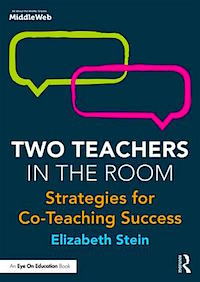It’s Time to Sharpen Your Co-Teaching Vision
A MiddleWeb Blog

Looking back to the beginning of school in the fall, how has your co-teaching vision been doing so far? Would you rate your co-teaching role over the last months as something close to crystal clear and productive?
Let yourself ponder this question for a few minutes. Maybe even jot down some thoughts and ideas. Once you have given yourself some time to consider, keep reading…I will begin with a little awareness and perspective.
(Once we’re done, remember to go to the comment section and share how your ideas might connect to and extend my thinking.)
Awareness:
Becoming more aware of what you see, how you feel, and what you are experiencing is a critical step.
Ask yourself, how is my year going so far? Are you and your co-teacher(s) moving forward collaboratively, with strong, intentional instructional moments each day?

Example:
A co-teacher is aware that she is exhausted every day. She does not feel like an active participant in daily lessons. She claims she “spins her wheels” trying to figure out how to implement strategies and be a consistent part of the instructional time in the classrooms where she works.
The evidence of this is that every time she tries to suggest a strategy or lesson activity, her co-teacher tells her, “Oh, we don’t have time for that.” In addition, her co-teacher often interrupts and “talks over her” as she tries to add her thinking and know-how during lessons.
This teacher can move beyond feeling frustrated by raising her awareness. Rather than just accepting a situation as “the way things are going to be” this co-teacher decides she will make sure, over time, to speak with her co-teacher in a pragmatic, yet persistent, manner about shared roles and mutual respect. She will select one to two lessons each week as a place to start becoming more active to meet the needs of all students in the moments of instructional time.
What comes to mind for you? What is an example of your co-teaching awareness?
 Perspective:
Perspective:
For our co-teaching vision to be 20/20, we must not only raise our awareness about our own thoughts and actions – we must also consider the perspectives of co-teaching partner(s), students, parents, and administrators. Every co-teacher needs to approach our instructional work with eyes wide open, paying attention to what others might be seeing.
Example:
A co-teacher receives a few unfavorable comments from an administrator during a walk-in observation. Initially this co-teacher feels defensive and deflated and chooses to just tread in muddy thoughts and make excuses for why this administrator made the comments.

Redirecting your 20/20 co-teaching vision
Rather than looking for possible reasons outside of the co-teacher’s control, 20/20 co-teaching vision will allow the co-teacher to enter this situation with humility by asking: What did I do or not do to encourage this comment from my administrator’s perspective? What can I learn and how may I better serve my students?
20/20 co-teaching vision will open up conversations with the administrator while reflecting on possible ways to take action toward improvement. With 20/20 co-teaching vision, this co-teacher can commit to ongoing productive efforts. 20/20 co-teaching vision embraces the fact that learning is a never-ending process.
What comes to mind for you? What is an example of perspective in your co-teaching experiences?
Taking action with 20/20 co-teaching vision
With sharp awareness and considered perspectives, the goal of collaborative action will fall into place more easily for co-teachers. It just makes sense, right? Communication will be open. Perspectives of students, parents, administrators, and co-teachers will be considered, valued, and embraced. Each co-teacher will each take responsibility for their part in every co-teaching experience.
No excuses. And a classroom filled with collective clarity may pave the way for effective and joyful co-teaching in 2020. Happy New Year, everyone!
What is your co-teaching vision so far? How can you fine tune your 20/20 co-teaching vision?
___________________________________

































Great advice and plans for co-teaching success.
1. My co-teaching vision so far is one where both the gen ed teacher and sped teacher collaborate to share a vision and clear goals for their classroom and students. Continuous planning and communication is key. Taking time to reflect on what the learning in the classroom may feel or look like to others is important. 2. I can fine tune my co-teaching vision by taking myself out of difficult situations and allowing myself to reflect on what the situations may look like to other people. Clear communications, expectations, and goals between both teachers are critical for the utmost success. This year I get the opportunity to work with 2nd grade again. I have worked with this team before, and we really work well together. The newest teacher to the team is an experienced teacher, and we will be able to bounce ideas off each other.